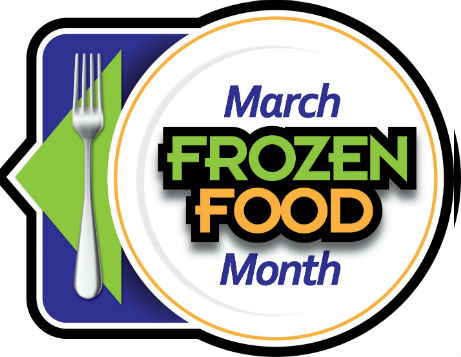
by Heidi Copeland | Feb 28, 2019
March is Frozen Food Month. In fact, the National Frozen & Refrigerated Foods Association (NFRA),Inc., likes to suggest that there is MEALTIME MAGIC in the FROZEN AISLE. I could not agree more!
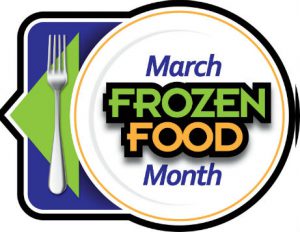
March is Frozen Food month. Photo Source: with permission from Frozen Food Alliance
Frozen foods are a smart choice. Frozen foods are always in season, last much longer than their fresh counterparts, are convenient, economical and full of variety. Plus, frozen foods can be portioned and packaged in ways that don’t leave anything to waste.
A lot has changed since 1925 when Clarence Birdseye was issued U.S. Patent #1,773,079, to freeze fish. This U.S. Patent marked the beginning of today’s frozen foods industry. In 1927, he extended the freezing process to quick-freezing meat, poultry, fruit, and vegetables. Birdseye’s initial introduction of 26 frozen foods has morphed to so many frozen products that the NFRA boasts over 3,700+ different choices. There is something FROZEN for every taste and every budget!
The modern day frozen product is generally supercooled at temperatures below -54°F. This supercooled fast freezing process produces smallish ice crystals that help foods retain their personal characteristics. Additionally, a lot of research goes into commercially frozen food’s packaging. Many frozen products can go directly from freezer to microwave, oven or even a pot of boiling water. Packaging must also consider the constraints of the home freezer knowing that its average temperature is around 0° or a bit below.
Although cold temperatures like 0°F or below puts a temporary hold on many biological processes microorganisms are not always killed off during freezing. It is important to recognize that proper care must be taken preparing some frozen foods.
In addition, when foods are frozen for extended periods of time or are frozen improperly, freezer burn can begin to develop on the food’s surface. Freezer burn happens when moisture in the outer layers of the food evaporates into the dry freezer air, leaving behind empty pockets in the tissue of the food. Freezer burn on meat is visible as brownish-white discolorations and on other foods dry, white spots. While it is not harmful to eat, freezer burn can adversely affect the flavor and texture of food.
It is easy to prevent freezer burn. One can easily reduce the food’s exposure to air through the use of correct wrap before storing food in the freezer. The National Center for Home Food Preservation (https://nchfp.uga.edu/how/freeze.html) has excellent information on how the use of proper packaging materials can protect the flavor, color, moisture content and nutritive value of foods from the arid climate of the freezer.
Frozen food packaging depends on the type of food to be frozen. In general, packaging materials must have certain characteristics:
- Moisture vapor resistant
- Durable and leakproof
- Not become brittle and crack at low temperatures
- Resistant to oil, grease or water
- Protect foods from absorption of off flavors or odors
- Easy to seal
- Easy to mark (with both content and date)
Additionally, a full freezer is the most energy efficient.
Posting a frozen foods inventory (list) near the freezer and keeping it up to date by listing the foods and dates of freezing is helpful. Remembering also to rotate foods in the freezer. An easy acronym for this is FIFO… First-In, First-Out. In other words, use the food stored the longest before you use the newest.
Moreover, purchase a thermometer if your freezer does not have an automatic temperature display. A freezer should be maintained at a temperature of 0°F or lower. At higher temperatures, foods lose quality much faster.
Most recently, a woman from North Carolina, Sheila Pulanco Russell, is credited with bringing a lifehack to the masses with her “how to” Facebook posting. I think it is a good thing to know. It is called the One Cup Tip. All it entails is putting a cup of water in the freezer, freezing it solid, and then placing a quarter on top of it and leaving it in the freezer.
When you return from an extended out of town trip you know if your power was out. It the quarter is sitting at the bottom of the cup you know your power was off too long and that your frozen food is not safe to eat. If the coin is in the middle of the cup, the outage was fairly short and your food should be good (frozen foods that still have their crystals are safe to eat and refreeze). If the coin is still on the top, then there was no power outage or just a quick one and all is well. Note: no one wants food poisoning, so if you are in doubt, throw the food out.
Have questions? Don’t hesitate to call your local county extension agent from the Cooperative Extension office; they’re free!
Heidi Copeland
Family and Consumer Sciences Extension Agent, III
University of Florida IFAS Extension
615 Paul Russell Road
Tallahassee, Florida 32301
hbc@ufl.edu
(850) 606-5203
The Foundation for The Gator Nation
An Equal Opportunity Institution

by Samantha Kennedy | Feb 28, 2019
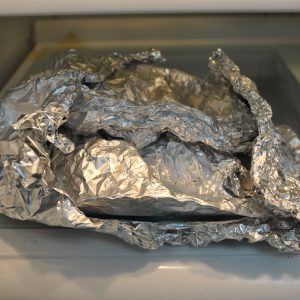
Storing foods in aluminum foil is a not a good food safety practice since it does not form a tight enough seal to keep out air, moisture, or microorganisms. Use air-tight containers or zipper plastic bags to store leftovers safely. (Photo source: Samantha Kennedy)
This month, I would like to focus on leftovers, more specifically, using and storing leftovers responsibly.
Many times, leftovers are saved with the best intentions. We really do plan to eat last night’s lasagna for dinner tonight, but then something better comes along and suddenly that lasagna gets pushed to the back of the refrigerator where it gets forgotten until the fridge is cleaned out two months later.
That dried out, fuzzy lump covered in foil? Well, it used to be lasagna. Now it is inedible, unsafe, and a waste of food and money.
I say, stop the madness! Show those leftovers a little love. If properly stored and handled, those boring leftovers can once again dazzle your palate.
First of all, proper storage is key. Whether being put in the refrigerator or freezer, wrap or store leftovers in an air-tight container. This will not only prevent cross-contamination by microorganisms, but will also help maintain flavor and quality.
The only exception to this is whole, fresh fruits and veggies, which need to be stored in the crisper drawer or on the countertop to allow air flow. Cut fruits and veggies should always be refrigerated.
The best materials for food storage are air-tight plastic or glass containers and paper or zipper bags made for freezer use. When using paper, be sure to wrap the food tightly and completely.
Aluminum foil, wax paper, and plastic wrap do not make effective wrappers for the freezer since they do not form a tight enough seal to prevent freezer burn.
Always label all leftovers, especially when freezing them, with the name of the food and the date it was stored. To ensure safety, discard refrigerated leftovers after five days and frozen leftovers after six months. Foods frozen longer will suffer significant quality loss.
Leftover foods like soups, stews, and casseroles make terrific quick meals for lunch or dinner. Simply divide the leftovers into single portions and freeze, or refrigerate if all portions will be eaten within five days.
Foods like leftover roasted chicken or breakfast bacon can be added to a salad or made into a sandwich. Today’s leftover pancakes can be tomorrow’s pancake parfait or breakfast sandwich bread.
Leftover scrambled eggs can be added to tonight’s fried rice. Last night’s chili can be made into today’s baked potato topping.
The possibilities are endless.
“Leftovers” does not have to be a dirty word. With a little planning, knowledge, and ingenuity, leftovers can easily become a family favorite. And the best part, saving leftovers means saving money, too.
For more information on food storage tips, try these publications from UF/IFAS Extension:
Healthy Eating: Food Storage Guide
Preserving Food: Freezing Vegetables
Extension classes are open to everyone regardless of race, creed, color, religion, age, disability, sex, sexual orientation, marital status, national origin, political opinions or affiliations.

by Judy Corbus | Dec 3, 2018
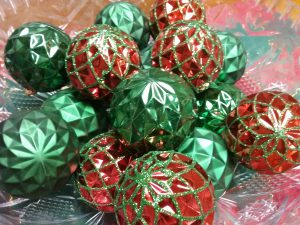
Photo source: UF/IFAS Northwest District
The holiday season is here and, with it, many colorful decorations, delicious treats, and fun events. There also are hidden dangers that can mar this special time of year if we aren’t careful. Follow these twelve tips for a safe holiday celebration:
- To reduce fire risk, do not connect more than three strings of incandescent lights. Follow label guidelines for stringing together LED lights. Check lights for frayed or exposed wires, loose connections, and broken sockets and replace as needed.
- Place candles on stable surfaces away from trees, curtains, and other flammable items and out of reach of children. Never leave burning candles unattended or sleep in a room with a lit candle. Consider using battery-operated candles.
- Use caution when decorating with “angel hair” and artificial snow. Angel hair is made from spun glass and can irritate eyes and skin; always wear gloves when handling or use non-flammable cotton instead. Artificial snow can irritate your lungs if inhaled; follow package directions carefully.
- Keep kids and pets in mind when decorating the tree. Place breakable ornaments or ones with metal hooks near the top out of reach of little hands, playful paws, and wagging tails.
- Use a sturdy step ladder, not chairs or other furniture, to reach high places. Get someone to “spot” you and assist with handing or taking items.
- If you use a fireplace, have your chimney checked and cleaned at least once a year by a certified chimney sweep. Cleaning removes soot and other by-products that can lead to chimney fires and carbon monoxide intrusion into your living space.
- Use special care when giving toys that use coin lithium batteries to children. Older children’s devices with these batteries can be enticing to young children. Ingestion of button batteries can cause serious injury or death. Lock away spare batteries and closely supervise young children around products with button batteries. In case of ingestion, contact the 24-hour National Battery Ingestion Hotline, (800) 498-8666.
- If you want to fry a turkey, consider using an oil-less turkey fryer or purchase a fried turkey from a professional establishment. The Consumer Product Safety Commission reports that since 2002, there have been 168 turkey-related fires, burns, explosions, or carbon monoxide poisoning incidents, 672 injuries, and $8 million in property damage. Don’t add to the statistic count!
- Use a food thermometer to ensure meat reaches a safe internal temperature. Click here for a convenient temperature chart.
- Refrigerate food within two hours. Cut leftover meat in small pieces and store foods in shallow containers so they will chill quickly. Use leftovers within four days or freeze or discard.
- Reheat sauces, soups, and gravies to a rolling boil before serving.
- Wash your hands frequently with soap and warm water to reduce your risk of illness.
Have a happy, healthy holiday season!
Sources:
National Safety Council
Chimney Safety Institute of America
Electrical Safety Foundation International
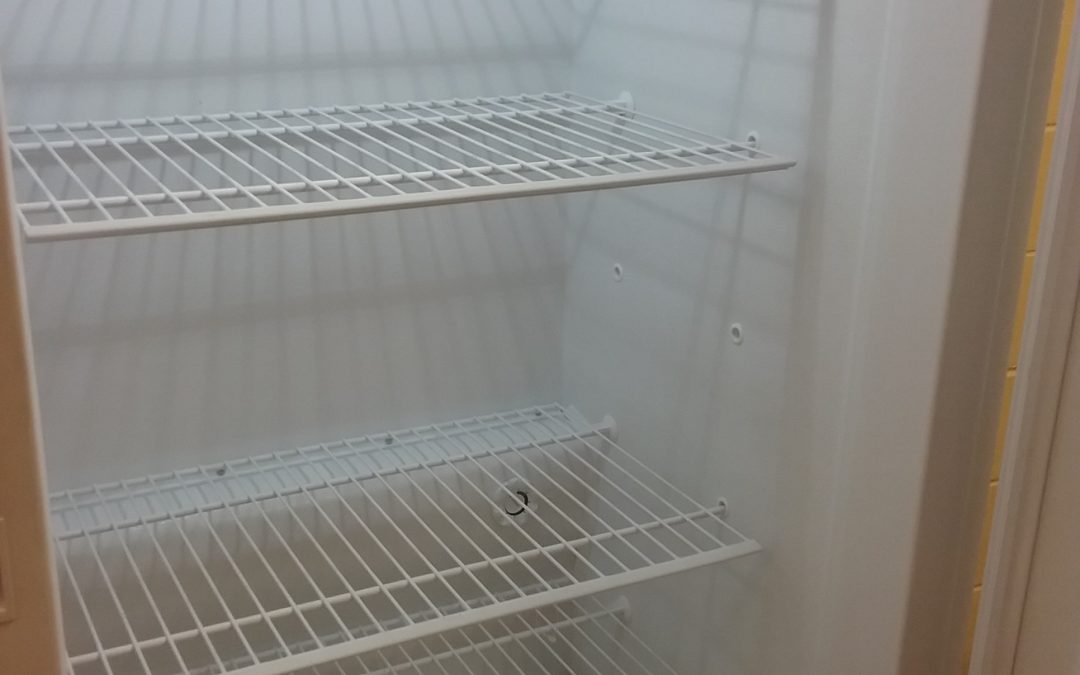
by Judy Corbus | Nov 15, 2018
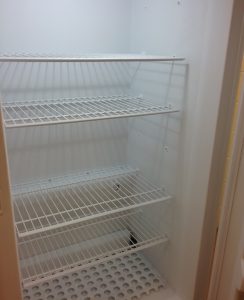
Photo source: UF/IFAS Northwest District
After an extended power outage, your refrigerator and freezer may develop unpleasant odors from spoiled food. To get rid of these odors, remove all food items and clean the inside, including drawers and bins, with a mild cleaning solution of dish soap and water. You also can use a solution of 2 tablespoons baking soda and 4 cups warm water. Strong cleansers may affect the taste of food or ice cubes or damage the interior finish. Rinse with a bleach solution of one tablespoon unscented chlorine bleach per gallon of water to sanitize. Lemon juice and water solutions are not strong enough to sanitize effectively. Leave the unit unplugged with the door open for 1-2 days to air out. Spray disinfectant around hinges, locks, and into any openings.
If odors persist, try one of these methods:
- Spread activated charcoal, clean cat litter, or baking soda on trays and place on refrigerator or freezer shelves. Activated charcoal is extra dry and absorbs odors more quickly than cooking-type charcoal. It is available at drug or pet supply stores. Run the appliance empty for 2-3 days. If the odor remains, replace with new charcoal and repeat.
- Place trays of freshly ground coffee on appliance shelves and close the door. Run the appliance empty for 2-3 days. If a slight coffee aroma remains, wash and rinse shelves and the aroma should dissipate.
- Pack each shelf with crumpled newspaper. Set a cup of water on the top shelf or sprinkle the newspaper with water. Allow appliance to run for approximately 5-6 days. While this method is time-consuming, it is effective in removing strong odors.
- Use a commercial product designed for refrigerator and freezer odor removal. These products are available at hardware, grocery, discount, and variety stores.
Once the odor is gone, rinse and dry the appliance. Don’t forget to clean gaskets with a mild cleaning solution and warm water; rinse and dry. Dirt and spills can prevent the gasket from sealing well, resulting in a loss of cold air and higher utility bills. Also, clean the coils and front grill with a brush or vacuum cleaner to remove dirt that can hinder air flow to the condenser.
Use an appliance thermometer to check the temperature of your refrigerator and freezer. The refrigerator should be between 33˚F and 40˚F and the freezer at 0 degrees or below.
If there is still an odor after trying these steps, it is possible meat or fish drippings have seeped into the insulation. An appliance service technician may need to remove the liner and replace the insulation or the appliance may need to be replaced.
Sources:
My Florida Home Book – University of Florida/IFAS Extension
Solving Odor Problems in Your Refrigerator or Freezer – University of Nebraska-Lincoln Cooperative Extension
When the Power Goes Off – Clemson Cooperative Extension
Cleaning the Fridge – North Carolina State University Cooperative Extension
by Samantha Kennedy | Oct 16, 2018
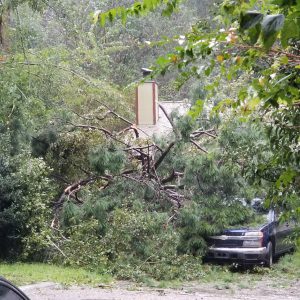
Downed trees and other debris should be handled carefully. Use proper equipment and follow all safety precautions to avoid injury. (Photo source: Samantha Kennedy)
Hurricane Michael was a storm of historic proportions, slamming into the Florida Panhandle and wreaking havoc on millions of people across the Big Bend region. Now that the storm has passed, the recovery phase has begun. Damage assessment, debris removal, structural repairs, and food safety concerns are just a few aspects of storm recovery, as people seek to rebuild their lives and return to a sense of normalcy.
There are a lot of things to think about after a disaster and it can be overwhelming. The first priority should always be basic necessities: food, water, and shelter. Make sure any structure is safe enough for habitation. If the structure’s integrity is compromised, seek alternate living arrangements.
Heed all boil water notices, if applicable. If boiling water is not possible, stick to using clean, bottled water for drinking, food preparation, and personal hygiene. Do not assume that because the food in the refrigerator is cool to the touch, that it is safe to eat. Perishable food must be kept at or below 40 degrees Fahrenheit to be considered safe. If it is uncertain as to whether that temperature was maintained while the power was out, the food should be discarded. Discard any perishable food from refrigerators after a power outage longer than 4 hours.
Be careful when assessing damage after the storm. Wear sturdy shoes and avoid wading through floodwaters. Wear a hat, sunglasses, and sunscreen when out in the sun. Drink plenty of clean water and maintain energy levels with small, nutrient-dense meals and snacks. Damaged tree limbs may continue to fall after the storm, so take heed of potential falling debris. Standing water can harbor snakes, fire ants, and other potentially dangerous critters, so take proper precautions at or around puddles or floodwater.
Use tools such as chainsaws and generators correctly and practice proper safety precautions. Do not run a generator inside and store gas cans a safe distance from both the generator and the living space. Allow others more skilled with using a chainsaw to help with debris collection and removal. If dealing with large amounts of mold, be sure to wear protective clothing and the proper respiratory mask to avoid contact with spores.
Unfortunately, many dishonest people take advantage of situations such as natural disasters to prey on those in need. Beware of people offering to help with repairs quickly and/or for an extraordinarily low price. Only hire reputable licensed contractors, even if that means having to wait for services. The Florida Department of Business and Professional Regulation myfloridalicense.com maintains a list of licensed contractors in the state of Florida. The Better Business Bureau provides ratings for a variety of businesses, including contractors. Use these resources as a guide to finding the right contractor.
Contact insurance companies as soon as possible after the storm to get the claims process rolling. Have the policy on hand when the call is made to make the process easier. It would be helpful to document any damage and have those photos available to share with the insurance agent or claims adjuster. Post-disaster is an extremely busy time for insurance companies, so be as cooperative and patient as possible during the process.
Disaster recovery is a very stressful time for everyone, often leading to confusion, anger, and helplessness. Reach out to existing support systems such as family, friends, churches, or other groups for emotional support. Practice self-care, such as regular meals and breaks. Establish a new normal routine and stick to it, especially for children. Most importantly, be kind to yourself and others during this difficult time.
The University of Florida IFAS Extension Service is a local resource for post-disaster education and assistance. More information about each of these topics and more can be provided by your local extension office.
The UF/IFAS Disaster Preparation & Recovery blog is a comprehensive resource to help with disaster recovery: http://disaster.ifas.ufl.edu/.
Extension classes are open to everyone regardless of race, creed, color, religion, age, disability, sex, sexual orientation, marital status, national origin, political opinions or affiliations.

by Amy Mullins, PhD, RDN | Aug 24, 2018
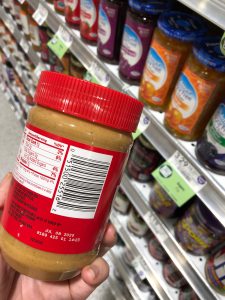
Photo source: UF/IFAS Northwest District
If your family is like most, grocery shopping is a dreaded weekly task. Typical shoppers usually have an idea of what they plan to purchase based on a previously made shopping list. Even then, it’s easy to go astray with impulse purchasing, bargain prices, and buy-one-get-one free opportunities that simply can’t be passed up! Before you know it, the shopping cart is loaded with delicious treasures just begging to come home with you.
Now that you have done the shopping, transported it home, and begun to put food items in their appropriate storage places, you realize the refrigerator, freezer, and pantry are cramped and nearly full. On a related aside, you should see my parents’ pantry. They have enough cans, boxes, and packages to feed their entire neighborhood…twice! Not to mention the two full size refrigerator/freezers that are bursting at the seams. Like my parents, I suspect many of us have a food overbuying addiction. So what happens next? Well, it’s time to clear out the old and make way for the new, of course. But how do you know what to purge and what is still good to keep?
Food Date Labeling Confusion and Food Waste
Standard or uniform language for food product dating does not exist in the U.S., which makes things tricky when it comes to deciphering expiration dates. Current Federal regulations do not require product dating (excluding infant formula), but instead allow food manufacturers to voluntarily set and display these dates on product packaging. With the lack of Federal measures, product dating enforcement is left up to individual states, resulting in consumer confusion over food safety. The U.S. wastes close to an estimated 40% of food produced annually, which equals approximately 160 billion pounds (Harvard Food Law and Policy Clinic). Of that, confusion over the meaning of date labels seems to be responsible for roughly 20% of safe and edible food wasted by consumers. Undoubtedly, this hurts purchaser’s pocketbooks and results in $29,000,000,000 of wasted consumer spending yearly (Food Date Labeling Act of 2016, 114th Congress 2D Session).
Food Quality vs. Food Safety
While cleaning out the pantry and cold storage, I also have been guilty of trashing perfectly good food. So many of us unknowingly accept the stamped date as common law not to be questioned. So what does that date actually mean?
The “open” date used by the manufacturer or retailer on food packaging is passively thought of by the consumer as the “expiration date,” or the last date a food can safely be eaten. This is a very common misconception. Food safety is not represented by this date, but rather it refers to product quality and freshness. Dates determined by food companies take into consideration such factors as ingredients, product characteristics and packaging, as well as time and temperatures associated with distribution, retail sale, and storage.
With no current standards in place, a variety of food date phrases are utilized which often are misleading to retailers and consumers. Most commonly used phrases include:
- “Best If Used By/Before” indicates when a product will be of best flavor or quality.
- “Sell-By” indicates to the retailer when the product should no longer be displayed for sale.
- “Use-By” is the last date recommended for use of the product at peak quality. This is only a safety date when used on infant formula packaging.
It’s important to remember that open dates on food products ONLY reflect food quality and NOT food safety (except for infant formula). For a list of specific foods and recommended storage time frames, check out the FoodKeeper resource at FoodSafety.gov.
Food Spoilage
Knowing the signs of spoilage will help you determine if a food is no longer fit for consumption. Although the quality date may have passed, the food is safe until it begins to spoil. Spoiled food may have a different smell, taste, and/or texture with sometimes visible discoloration. This occurs when environmental conditions (such as temperature, moisture, and oxygen) are introduced which support the growth of bacteria, molds, or yeasts. Given enough time, these microorganisms multiply rapidly and affect the safety of the food. If perishable items are not handled and stored properly, spoilage occurs much more rapidly. Learn more about proper refrigeration and food safety.
Do Your Part at Home
- Plan meals in advance and make a specific grocery list. Check the refrigerator, freezer, and pantry to utilize what you already have on hand.
- Don’t overbuy! Especially be aware not to purchase excess perishable items that are likely to spoil quickly. These may be foods that require cold storage, fresh bakery items, and fresh produce.
- Always look for and compare date labels of an item; choose the one with a later date.
- Store foods promptly and properly for food safety and best quality. Discard potentially hazardous cold food items that have not been properly refrigerated for 2 hours or more.
- Keep a thermometer inside the front of your refrigerator and check it regularly to be sure it stays below 40 degrees F.
- Thaw foods safely! Thawing in the refrigerator is the safest way, but using cold running water or defrosting in the microwave are acceptable ways to speed up the process. Never sit foods out at room temperature to thaw!
- Recognize the signs of food spoilage and promptly discard foods that smell funny, have off-flavors, obvious mold growth, or sticky or slimy textures (such as fish, poultry, and deli meats).
- Evaluate each item in your pantry and consider whether or not it’s something you want to continue to store and use or want to remove.
- High temperatures affect the shelf life of shelf-stable foods so it’s important to store dry goods and pantry items in temperatures at or below 85 degrees F. Use the “First In First Out” (FIFO) method of rotation, using older items before newly purchased ones. Read more about Shelf Stable Food Safety.
- Discard cans that are rusty, bulging, or leaking, as they are at a high risk for containing the deadly pathogen that causes Botulism. Never taste suspicious foods! Take extra caution by disposing of cans and jars into a tightly closed plastic bag before placing in an outside trash receptacle.
Help Families in Need & Keep Unused Wholesome Food Out of Landfills
Mistakenly discarded food products, not only is the U.S. but globally, have created a sad cascade of wasted resources and money with increasingly negative environmental and social implications. Food banks and local community organizations have plenty of under-served and needy families who can benefit! Remember, it’s safe to donate dry and canned goods, perishables, and other food related items that are beyond the quality date of the product.
Find a food bank near you.
We all can do our part to reduce the amount of wasted food, save money, help the environment, and help our communities!
Additional Resources:
https://www.usda.gov/oce/foodwaste/sources.htm
https://www.usda.gov/oce/foodwaste/resources/donations.htm
USDA Food Safety Information, Food Product Dating
USDA Food Labeling Fact Sheets











